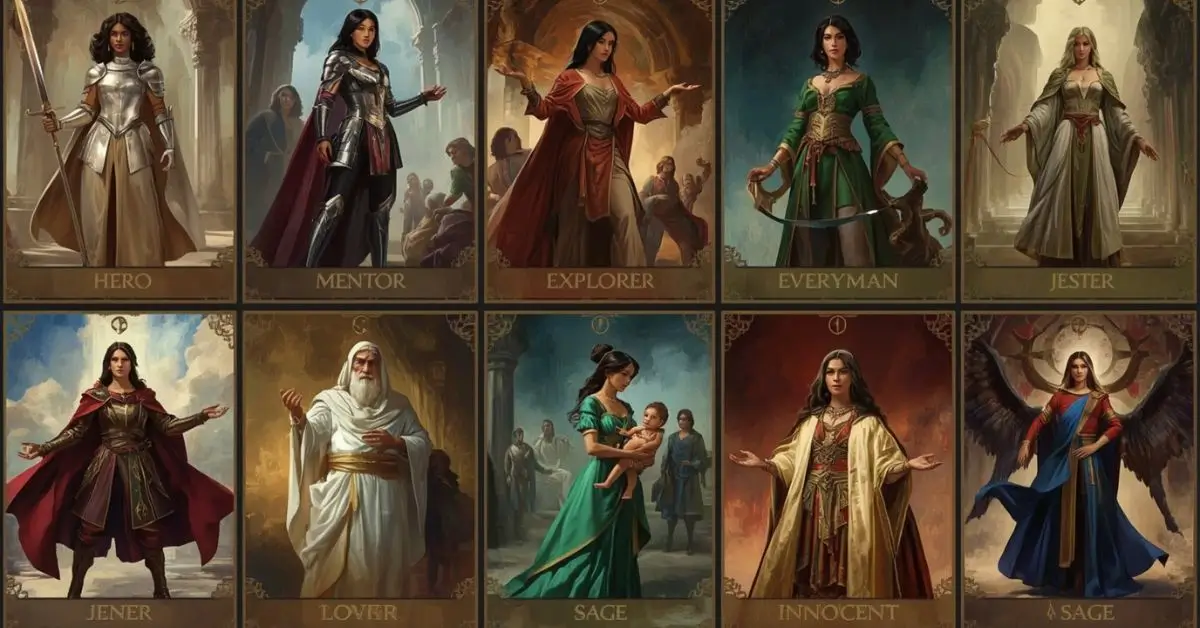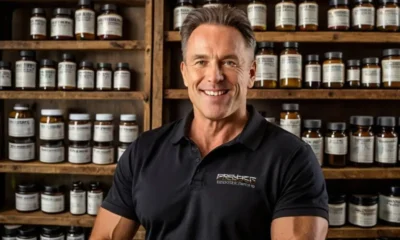GENERAL
Character Archetypes: Building Memorable Characters in Stories

Understanding character archetypes is crucial if you want to write stories that capture hearts and leave lasting impressions. Whether you’re a novelist, screenwriter, teacher, or content creator, mastering character archetypes helps you structure characters in a way that resonates with readers across cultures and generations.
In this guide, we will explore the 12 classic character archetypes, how they function, and why they are essential. We’ll also offer a comparison chart, writing tips, and frequently asked questions to make your storytelling more impactful and professional.
What Are Character Archetypes?
Character archetypes are universal roles that appear in stories, films, myths, and folklore. They are templates for characters who share similar traits, behaviors, and motivations, regardless of cultural background.
These archetypes reflect real human emotions and experiences, which is why audiences easily relate to them. For instance, most stories have a Hero, a Villain, a Mentor, or a Love Interest—and for a good reason. They help the audience understand the character’s role instantly.
Why Are Character Archetypes Important in Storytelling?
Using character archetypes allows storytellers to:
- Create relatable characters: Audiences quickly recognize the character’s purpose.
- Maintain balance: Archetypes help diversify character dynamics in a story.
- Build story structure: They act as plot anchors, guiding the narrative forward.
The 12 Classic Character Archetypes
Let’s explore the twelve foundational character archetypes and what makes each one unique.
Hero
The Hero is the central figure in a story. This character is brave, determined, and often goes on a journey to achieve something important. They face challenges, grow emotionally, and become a better version of themselves.
Traits: Courageous, goal-driven, inspiring
Examples: Luke Skywalker, Katniss Everdeen
Mentor
The Mentor teaches and guides the Hero. Often wise and experienced, this character helps the Hero discover their potential and prepares them for upcoming challenges.
Traits: Wise, nurturing, strategic
Examples: Gandalf, Dumbledore
Villain (Shadow)
The Villain or Shadow represents opposition to the Hero. They often have their own goals, usually in conflict with the Hero’s, and pose the main threat.
Traits: Manipulative, powerful, determined
Examples: Darth Vader, The Joker
Love Interest
The Love Interest brings emotional depth to the story. They are often the Hero’s romantic partner but also play a vital role in the Hero’s growth.
Traits: Compassionate, alluring, supportive
Examples: Rose (Titanic), Lois Lane (Superman)
Trickster
The Trickster brings humor or unpredictability. This archetype challenges the status quo and can either help or hinder the Hero.
Traits: Clever, mischievous, witty
Examples: Jack Sparrow, Loki
Outlaw (Rebel)
The Outlaw resists rules and social norms. Though often misunderstood, they have strong personal values and fight for what they believe is right.
Traits: Bold, radical, free-spirited
Examples: Han Solo, Lisbeth Salander
Caregiver
The Caregiver prioritizes the needs of others. They are nurturing, loving, and often take risks to protect their loved ones.
Traits: Loyal, empathetic, selfless
Examples: Sam (Lord of the Rings), Marlin (Finding Nemo)
Innocent
The Innocent believes in goodness and wants a peaceful world. They are honest, optimistic, and often see the best in people.
Traits: Pure, hopeful, trusting
Examples: Buddy (Elf), Dorothy (Wizard of Oz)
Explorer
The Explorer seeks adventure, discovery, and growth. They hate being confined and are constantly searching for new experiences.
Traits: Curious, restless, independent
Examples: Indiana Jones, Moana
Sage
The Sage offers wisdom, knowledge, and insight. They help the Hero see the truth and make better decisions.
Traits: Intelligent, thoughtful, spiritual
Examples: Yoda, Rafiki
Creator
The Creator is driven by imagination. They build, design, and innovate, whether through art, technology, or ideas.
Traits: Creative, visionary, passionate
Examples: Tony Stark, Leonardo da Vinci
Ruler
The Ruler desires control and order. They are natural leaders who take responsibility and create systems.
Traits: Confident, commanding, organized
Examples: Mufasa, Queen Elizabeth I
How to Use Character Archetypes Effectively
- Mix and evolve archetypes – Your Hero can also be a Creator or Explorer.
- Avoid clichés – Make characters unique by giving them personal quirks and flaws.
- Use supporting archetypes – Surround your main character with diverse roles to strengthen your narrative.
- Align with your plot – Choose archetypes that naturally fit the story’s theme.
Character Archetypes Comparison Table
| Archetype | Goal | Strengths | Weaknesses | Use in Story | Complexity Level |
| Hero | Overcome challenge | Courage, resilience | Arrogance, doubt | Main plot driver | Moderate |
| Villain | Disrupt progress | Power, strategy | Pride, cruelty | Main obstacle | High |
| Mentor | Teach & support | Wisdom, experience | Distant, cryptic | Guide for the hero | Low |
| Trickster | Break the norm | Humor, wit | Unpredictable | Comic relief/conflict | Moderate |
| Caregiver | Protect others | Loyalty, kindness | Overprotective | Emotional anchor | Low |
How Character Archetypes Help in Story Development
- Create balance: Every story benefits from a blend of multiple archetypes.
- Reveal character growth: Watching an archetype evolve (e.g., Innocent becoming Hero) adds depth.
- Enhance audience connection: People relate to character types because they mirror real-life personalities.
“Archetypes are not rigid molds, but flexible blueprints. Great writers shape them into something fresh and unforgettable.” — StoryCraft Academy
Tips for Writers Using Character Archetypes
- Begin with an archetype, then add layers.
- Study myths, legends, and popular films to see archetypes in action.
- Give your character a backstory that justifies their archetype.
- Introduce internal conflicts; even Heroes should have doubts.
Conclusion
Understanding and utilizing character archetypes can revolutionize your writing. These timeless patterns help create well-rounded, relatable, and dynamic characters that audiences instantly connect with. Whether you’re crafting a fantasy epic or a simple children’s tale, using archetypes as a foundation makes your storytelling more powerful and structured.
From Heroes who fight for justice to Sages who offer wisdom, each archetype plays a vital role in shaping the narrative. By combining archetypes with your unique vision, you can breathe life into unforgettable characters.
FAQs
What are character archetypes used for in writing?
They help structure stories and create characters that are instantly recognizable and relatable.
Can a character have more than one archetype?
Yes, many complex characters blend multiple archetypes, such as a Hero who is also a Rebel or a Sage.
How do character archetypes help readers?
They make it easier for readers to understand roles and connect emotionally with characters.
Are character archetypes the same in all cultures?
While the core traits are universal, cultural variations exist in how they are portrayed.
How do I avoid clichés when using archetypes?
Add originality through backstory, motivations, and conflicts to keep the character fresh.
What’s the difference between a stereotype and an archetype?
Stereotypes are oversimplified and often negative; archetypes are foundational character models with depth and potential.
GENERAL
What Are Guinness Calories? Simple Nutrition Facts 2025

Ever wonder if your beloved pint is sneaking in more calories than you’d like? You’ve been there. I’ll help you understand [guinness calories] the smart way—no fluff, just real-world facts and easy clarity.
Quick Answer
A pint (16 oz) of Guinness Draught has about 210 calories (about 35 kcal per 100 ml). Calories come mainly from alcohol and carbs. Simple, direct, no guesswork.
What’s in a 12-oz Guinness Draught?
This tells you exactly what’s in a standard serving.
You’ll learn the facts fast:
- 12 oz (~355 ml) of Guinness Draught has 125 calories (Alcohol 11.2 g, carbs 10 g).
- That’s ~35 kcal per 100 ml for Guinness Draught or Extra Stout. A full pint rounds to ~210 calories total.
Key Intake: A full pint = ~210 kcal; most calories come from alcohol.
How Do Variants Stack Up?
See how different types compare no guessing here.
| Variant | Calories (per 12 oz) | Key Notes |
| Draught | ~125 kcal | Standard, smooth |
| Foreign Extra Stout | ~194 kcal | Rich, roasty |
| Baltimore Blonde Lager | ~167 kcal | Hoppy, lighter |
| Guinness Smooth (per 100 ml) | ~57 kcal (~217 kcal pint) |
Key Intake: Higher ABV = more calories. Pick the one that fits your macro budget.
Why Calories Vary Breakdown by Source

Learn where the calories come from, not just numbers.
- Alcohol has 7 kcal per gram; in Draught, ~62% of calories are from alcohol.
- Carbs add the rest—around 10 g in a 12-oz Draught (~40 kcal).
Key Intake: Calories split roughly 60% alcohol, 40% carbs.
Non-Alcoholic and Low-Cal Alternatives
Find choices when you want flavor without the calorie hit.
- Guinness 0: only 17 kcal per 100 ml (≈ 68 kcal per pint).
- Good picks if you’re tracking macros or avoiding alcohol.
Key Intake: Guinness 0 is a clever low-calorie swap for your pint fix.
What This Means for Dieters & Health-Mindful Drinkers
A quick guide to fit Guinness into your nutrition plan.
- A pint ~ 210 kcal is moderate—less than many craft ales (160–180 kcal).
- If counting macros, know: alcohol is the main calorie source.
Key Intake: It’s not “diet-friendly” but moderate and trackable.
Final Takeaway
This isn’t sugar-coated. If you’re watching your calories, understanding “guinness calories” means choosing wisely, knowing exactly what’s in your pint, and fitting it into your wellness plan like a smart decision, not a hidden cost.
FAQ’s
How many calories are in a pint of Guinness?
~210 kcal per pint, based on ~35 kcal per 100 ml.
What’s the calorie content of a 12-oz Guinness Draught vs Extra Stout?
Draught ~125 kcal; Extra Stout ~180–194 kcal.
Are there lower-calorie alternatives to Guinness stout?
Yes—Guinness 0 has only ~17 kcal per 100 ml (≈ 68 kcal per pint).
Guinness calories vs Bud Light: which is lower?
Guinness Draught (~125 kcal) is similar or slightly higher than Bud Light (~110 kcal).
How many calories per gram of alcohol are in Guinness?
Alcohol contributes 7 kcal per gram; ~60% of calories in Draught come from alcohol.
Calories in Guinness Draught nutritional facts explained?
~125 kcal from alcohol (78 kcal) + carbs (~40 kcal), plus ~1 g protein.
Is Guinness high in calories for a diet plan?
It’s moderate; track it, and it can fit in but be mindful of alcohol calories.
Expert Citations
- Healthline: Detailed breakdown of calories from alcohol vs carbs in Guinness Draught.
- Guinness.com: Official calorie counts across variants (Draught, Extra Stout, 0.0, etc.).
- Guinness product pages: Precise nutrition data for each variant – Draught, Foreign Extra Stout, Blonde, Smooth, etc.
GENERAL
Why the Rory Masters Collapse Still Matters Today (2025)

Golf can be cruel. One minute you’re leading the Masters, the next you’re fighting to hold it together. Rory Masters collapse moments have given fans drama, heartbreak, and unforgettable TV.
We’ve all seen it happen, the missed shots, the tense body language, the scoreboard slipping away. But why does it happen to a player as good as Rory McIlroy? Let’s break it down.
Quick Answer
The Rory Masters collapse refers to multiple high-profile moments at Augusta where Rory McIlroy lost his lead, most famously in 2011 when he shot 80 in the final round, and again in 2025 with late-round bogeys. Causes include mental pressure, course difficulty, and external distractions like slow play. Yet, Rory has also turned these failures into motivation, ultimately winning the Masters in 2025 to complete his career Grand Slam.
Rory McIlroy: Masters Career Profile
| Category | Details |
| Name | Rory McIlroy |
| Date of Birth | May 4, 1989 (age 36) (ESPN.com) |
| Hometown | Holywood, Northern Ireland (ESPN.com) |
| Turned Pro | 2007 (ESPN.com) |
| Masters Titles | 2025 (First win; career Grand Slam completed) (Reuters, The Washington Post) |
| Notable Collapses at Masters | 2011 final-round meltdown (80, from 4-shot lead) (Wikipedia) |
| Masters Attempts Before Win | 17 attempts at Augusta by 2025 (The Sun) |
| Other Major Wins | U.S. Open 2011, PGA Championship 2012 & 2014, Open Championship 2014 (Data Golf, Wikipedia, Reuters) |
| Total Career Wins (2025) | 44 total: 29 PGA Tour, 18 European Tour, others (Talksport) |
| Career Grand Slam | Achieved with 2025 Masters win; one of six to do so (Reuters, Talksport) |
| Signature Moment | Emotional collapse to celebrating Green Jacket after playoff win vs. Justin Rose (The Washington Post) |
| Key Strengths | Multiple Majors, career Grand Slam, long-time world No.1 (European Tour, Reuters) |
| Resilience & Legacy | Climbed back from 2011 collapse to claim Masters, completing a decade-long quest (The Scottish Sun, Reuters) |
2011 The Collapse That Started It All
The first big Rory Masters collapse came in 2011.
- Rory led by four shots after three rounds.
- On Sunday, Augusta’s pressure took over.
- He shot an 80 and finished tied for 15th.
2025 A New Collapse, Same Augusta Pressure
Fast forward to 2025. Rory was 4-under through 14 holes in Round 1.
- Then came bogeys on 15 and 16.
- A double bogey on 17 sealed the damage.
Paul McGinley, former Ryder Cup captain, called it a slow play distraction McIlroy couldn’t shake. This wasn’t the first time Rory felt Augusta’s mental toll.
Why Collapses Happen at Augusta
Definition:
Mental collapse in golf Majors is when focus, rhythm, and execution fall apart under tournament stress.
Augusta National tests more than swing mechanics. It pushes the mind to breaking point.
Key factors:
- Course design: punishes tiny errors.
- Crowd energy: amplifies every mistake.
- Mental game: pressure spikes near the finish.
Rory’s Redemption 2025 Masters Win
Here’s the twist: despite the early stumble, Rory fought back. By Sunday evening, he wore the green jacket.
- He became only the 6th golfer to complete the career Grand Slam delay McIlroy had chased for over a decade.
- His win proved collapse doesn’t have to define you.
What Fans and Players Can Learn
- Stay present: Focus on one shot at a time.
- Adapt fast: Don’t let a bad hole become a bad round.
- Pressure prep: Simulate high-stakes moments in practice.
Real-world note:
I’ve seen players choke in local tournaments because they never practiced the mental side. Rory’s story shows why it matters.
FAQs
Why is Rory McIlroy’s Masters collapse famous?
It’s remembered for how quickly a winning position turned into a blowout, especially in 2011 when he led by four shots.
How many times has Rory collapsed at the Masters?
At least twice in high-profile ways — 2011’s final-round meltdown and the 2025 early-round stumble.
What caused Rory’s 2025 collapse?
Analysts point to mental pressure and slow play distractions from his group.
Has Rory ever recovered from a Masters collapse?
Yes. He won the Masters in 2025, securing his career Grand Slam.
Expert Citations
- Paul McGinley — TalkSport: “Slow play affected Rory’s rhythm.”
- Golf.com — “Analyst says slow play led to Rory’s Masters collapse.”
- Wall Street Journal — “McIlroy completes career Grand Slam with 2025 Masters win.”
GENERAL
What to Know About Johnny Depp Island in the Bahamas

You’re curious, and honestly—so am I. What’s it like to own a slice of Caribbean magic, hidden away from prying eyes? Especially when that slice belongs to a Hollywood legend. Let’s cut through the noise and get real.
Quick Answer
Johnny Depp’s Island is called Little Hall’s Pond Cay. He bought it in 2004 for about $3.6 million. It spans roughly 45 acres and is 60 miles southeast of Nassau in the Bahamas. He still owns it as of mid-2025.
Where is Johnny Depp’s Island located?
Here’s what you’ll learn: Its geography, how big it is, and where it sits in paradise.
- Located in the Exuma Islands, Bahamas, about 60 miles southeast of Nassau (Tuko.co.ke – Kenya News, Market Realist, News).
- Covers roughly 45 acres (18 hectares), a sizable tropical property with six beaches (Tuko.co.ke – Kenya News, Newszetu).
It’s a mid-size tropical hideaway, a boat-ride from Nassau. Pure, quiet, untouched.
What’s the story behind its name and purchase?
Here’s what you’ll learn: Why Johnny Depp bought it, what he named parts of it, and how he transformed it.
- Johnny Depp Island was discovered while filming Pirates of the Caribbean. He bought it in 2004 for about $3.6 million (Vanity Fair, News, Homes & Gardens).
- The six beaches are named after his loved ones and mentors—Gonzo (Hunter S. Thompson), Lily Rose, Jack, Brando (Marlon Brando), and Paradis (Vanessa Paradis) (Vanity Fair, Market Realist, People.com).
- He built a ranch-style main house with 360° views, solar-powered guest structures, a bamboo yurt, and a beach house—low-key luxury meets eco-sensitivity (DDW, Tinseltown Tales, DMARGE, CEO Today).
What makes it a sanctuary—and does Depp still own it?
Here’s what you’ll learn: Why it’s meaningful to Johnny Depp and if he still owns it.
- Depp calls Johnny Depp Island “pure and beautiful” and says you can feel your “pulse drop” there—instant freedom (Vanity Fair, Newszetu, Tinseltown Tales).
- As of mid-2025, he still owns it despite rumors of a sale to J.K. Rowling (CEO Today).
Celebrity & luxury context
Here’s what you’ll learn: How it fits with celeb real-estate and pop culture.
- Johnny Depp Island sits among other Bahamas celebrity islands, near properties owned by Eddie Murphy and David Copperfield (Tuko.co.ke – Kenya News).
- The island has hosted Depp’s wedding to Amber Heard in 2015 and served as a detox retreat during difficult times (Glamour, DMARGE, Market Realist).
Takeaway
From celebrity news readers to luxury travellers to real-estate enthusiasts, Little Hall’s Pond Cay—better known as Johnny Depp Island—is a rare, personal hideout that blends Depp’s eclectic style with genuine peace. Based on real-world reports and Depp’s own words, this island is more than property—it’s sanctuary.
FAQ’s
Where is Johnny Depp’s island located?
A private island called Little Hall’s Pond Cay, in the Exuma chain, 60 miles southeast of Nassau, Bahamas.
What is the name of Johnny Depp’s private island?
It’s called Little Hall’s Pond Cay.
How much did Johnny Depp’s island cost?
He bought it for around $3.6 million in 2004.
Can you visit Johnny Depp’s island in the Bahamas?
No—access is strictly by invitation only.
What’s the history of Johnny Depp’s Little Hall’s Pond Cay?
He discovered it during Pirates of the Caribbean filming, bought it, built eco-homes, and still owns it as of 2025.
What are some luxury aspects similar to this island?
Think celebrity-owned private islands—secluded, bespoke retreats designed for quiet, high-end living.
Expert Sources
- Vanity Fair – Their coverage on Johnny Depp Island includes direct quotes and historical context from the actor himself. (vanityfair.com)
- People Magazine – Their article on Johnny Depp Island offers fact-checked property details and insider background. (people.com)
- Homes & Gardens – A respected home and lifestyle publication that provides credible real-estate insights, including luxury property features and valuations for celebrity-owned estates. (homesandgardens.com)
-

 GENERAL5 months ago
GENERAL5 months agoGary Brecka Supplements: Unlocking Peak Human Performance
-

 GENERAL5 months ago
GENERAL5 months agoActivia Yogurt Nutrition Facts You Shouldn’t Ignore
-

 HEART TIPS5 months ago
HEART TIPS5 months agoCommon Heart Home Health: Trusted Cardiac Care at Home
-

 GENERAL5 months ago
GENERAL5 months agoHealthy Living at Home for a Better You
-

 GENERAL5 months ago
GENERAL5 months agoWaterless Skincare: The Future of Potent, Eco-Friendly Beauty
-

 HEART TIPS5 months ago
HEART TIPS5 months agoTheralogix NeoQ10 Coenzyme Q10 Supplement – Heart Health
-

 HEART TIPS5 months ago
HEART TIPS5 months agoHeart Home Health Care: A Lifeline of Medical Excellence
-

 GENERAL5 months ago
GENERAL5 months ago12 oz Coke Nutrition Facts: What’s Really Inside?
